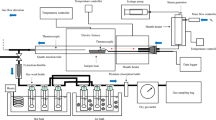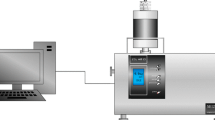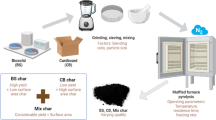Abstract
This study explored the composition and energy potential of university solid waste (USW) in China. Five combustible components, namely hard plastics (HP), paper (PP), soft plastics (SP), biomass (BM), and rubber (RB), were screened with the compositions 51%, 29%, 9%, 4%, and 3%, respectively. Each USW sample was gasified using a thermogravimetric analyzer (TGA) coupled with mass spectrometry (MS) at the heating rates of 5, 10, and 15 ℃/min and a final process temperature of 900 ℃. Thermal weight loss (TG) curves exposed the degradation in the order HP > SP > RB > BM > PP. Derivative thermogravimetric (DTG) peaks revealed that HP, PP, BM, and SP were degraded in three temperature-oriented phases in the range 172–731 ℃. The RB took an additional phase in the range 584–660 ℃. Major released gases, H2, CH4, CO, and CO2, were detected using MS via mass-to-charge (m/z) ratios. Higher H2 and total gas yield produced in the case of the HP dominated other materials at the lower heating rate of 5 ℃/min. Validation of data was assessed by equating experimental and calculated curves; therefore, the regression coefficient (R2) ranged between 0.884 and 0.997. The kinetics of the process were estimated by applying the Flynn–Wall–Ozawa (FWO) model at the conversion rates (α) of 0.2, 0.5, and 0.8, which presented reasonable results. Overall, the lower heating rates supported higher thermal conversion and a high quantity of gaseous products for all the components.






Similar content being viewed by others
Data availability
The datasets used and/or analyzed during the current study are available from the corresponding author on reasonable request.
References
Adeniran A, Nubi A, Adelopo A (2017) Solid waste generation and characterization in the University of Lagos for a sustainable waste management. Waste Manag 67:3–10. https://doi.org/10.1016/j.wasman.2017.05.002
Ali M, Huang Q, Lin B, Hu B, Wang F, Chi Y (2018) The effect of hydrolysis on combustion characteristics of sewage sludge and leaching behavior of heavy metals. Environ Technol 39(20):2632–2640. https://doi.org/10.1080/09593330.2017.1363296
Chen S, Meng A, Long Y, Zhou H, Li Q, Zhang Y (2015) TGA pyrolysis and gasification of combustible municipal solid waste. J Energy Inst 88(3):332–343. https://doi.org/10.1016/j.joei.2014.07.007
Cheng K, Winter WT, Stipanovic AJ (2012) A modulated-TGA approach to the kinetics of lignocellulosic biomass pyrolysis/combustion. Polym Degrad Stab 97(9):1606–1615. https://doi.org/10.1016/j.polymdegradstab.2012.06.027
De Vega CA, Benítez SO, Barreto MER (2008) Solid waste characterization and recycling potential for a university campus. Waste Manag 28:S21–S26. https://doi.org/10.1016/j.wasman.2008.03.022
De Vega CA, Benitez SO, Barreto MER (2003) Mexican educational institutions and waste management programmes: a University case study. Resour Conserv Recycl 39(2003):283–296. https://doi.org/10.1016/S0921-3449(03)00033-8
Doherty W, Reynolds A, Kennedy D (2009) The effect of air preheating in a biomass CFB gasifier using ASPEN Plus simulation. Biomass Bioenergy 33(9):1158–1167. https://doi.org/10.1016/j.biombioe.2009.05.004
Felder MA, Petrell RJ, Duff SJ (2001) A solid waste audit and directions for waste reduction at the University of British Columbia. Canada Waste Manag Res 19(4):354–365. https://doi.org/10.1177/0734242X0101900412
Figueira CE, Moreira PF Jr, Giudici R (2015) Thermogravimetric analysis of the gasification of microalgae Chlorella vulgaris. Bioresour Technol 198:717–724. https://doi.org/10.1177/0734242X0101900412
Garcia-Maraver A, Perez-Jimenez JA, Serrano-Bernardo F, Zamorano M (2015) Determination and comparison of combustion kinetics parameters ofagricultural biomass from olive trees. Renew Energy 83:897–904. https://doi.org/10.1016/j.renene.2015.05.049
Gebreeyessus GD, Berihun D, Terfassa B (2019) Characterization of solid wastes in higher education institutions: the case of Kotebe Metropolitan University, Addis Ababa Ethiopia. Int J Environ Sci Technol 16:3117–3124. https://doi.org/10.1007/s13762-018-1953-y
Gunasee SD, Carrier M, Gorgens JF, Mohee R (2016) Pyrolysis and combustion of municipal solid wastes: Evaluation of synergistic effects using TGA-MS. J Anal Appl Pyrolysis 121:50–61. https://doi.org/10.1016/j.jaap.2016.07.001
Huang Z, Ye Qq, Teng Lj (2015) A comparison study on thermal decomposition behavior of poly (l-lactide) with different kinetic models. J Therm Anal Calorim 119(3). https://doi.org/10.1007/s10973-014-4311-4
Issac M, Dai B, Zhang L (2019) Kinetics underpinning the C-CO2 gasification of waste tyre char and its interaction with coal char upon co-gasification. Fuel 256:115991. https://doi.org/10.1016/j.fuel.2019.115991
Jain AA, Mehra A, Ranade VV (2016) Processing of TGA data: Analysis of isoconversional and model fitting methods. Fuel 165:490–498. https://doi.org/10.1016/j.fuel.2015.10.042
Kataki R, Konwer D (2001) Fuelwood characteristics of some indigenous woody species of north-east India. Biomass Bioenergy 20(1):17–23. https://doi.org/10.1016/S0961-9534(00)00060-X
Lahijani P, Mohammadi M, Rahman A (2019) Investigation of synergism and kinetic analysis during CO2 co-gasification of scrap tire char and agro-wastes. Renew Energy 142.https://doi.org/10.1016/j.renene.2019.04.113
Lahijani P, Zainal A, Abdul Rahman M, Maedeh M (2013) Co-gasification of tire and biomass for enhancement of tire-char reactivity in CO2 gasification process. Bioresour Technol 138:124–130. https://doi.org/10.1016/j.biortech.2013.03.179
López-González D, Fernandez-Lopez M, Valverde J, Sanchez-Silva L (2014) Comparison of the steam gasification performance of three species of microalgae by thermogravimetric–mass spectrometric analysis. Fuel 134:1–10. https://doi.org/10.1016/j.fuel.2014.05.051
Mason I, Brooking A, Oberender A, Harford J, Horsley P (2003) Implementation of a zero waste program at a university campus. Resour Conserv Recycl 38(4):257–269. https://doi.org/10.1016/S0921-3449(02)00147-7
McKendry P (2002) Energy production from biomass (part 1): overview of biomass. Bioresour Technol 83(1):37–46. https://doi.org/10.1016/s0960-8524(01)00118-3
Meng A, Chen S, LongY ZH, Zhang Y, Li Q (2015) Pyrolysis and gasification of typical components in wastes with macro-TGA. Waste Manag 46:247–256. https://doi.org/10.1016/j.wasman.2015.08.025
Painter K, Thondhlana G, Kua HW (2016) Food waste generation and potential interventions at Rhodes University South Africa. Waste Manag 56:491–497. https://doi.org/10.1016/j.wasman.2016.07.013
Ridout AJ, Carrier M, Görgens J (2015) Fast pyrolysis of low and high ash paper waste sludge: Influence of reactor temperature and pellet size. J Anal Appl Pyrolysis 111(64–75):1. https://doi.org/10.1016/j.jaap.2014.12.010
Sebola R, Mokgatle L, Aboyade A, Muzenda E (2013) Solid waste quantification for the University of Johannesburg's waste to energy project. Int'l Journal of Research in Chemical, Metallurgical and Civil Engg 1 ISSN 2349–1442 EISSN 2349–1450. http://hdl.handle.net/10210/13011
Sircar I, Sane A, Wang W, Gore JP (2014) Experimental and modeling study of pinewood char gasification with CO2. Fuel 119:38–46. https://doi.org/10.1016/j.fuel.2013.11.026
Smyth DP, Fredeen AL, Booth AL (2010) Reducing solid waste in higher education: The first step towards ‘greening’a university campus. Resour Conserv Recycl 54(11):1007–1016. https://doi.org/10.1016/j.resconrec.2010.02.008
Sorum L, Grønli MG, Hustad JE (2000) Pyrolysis characteristics and kinetics of municipal solid wastes. Fuel 80(9):1217–1227. https://doi.org/10.1016/S0016-2361(00)00218-0
Taghizadeh S, Ghassemzadeh HR, Vahed MM, Fellegari R (2012) Solid waste characterization and management within university campuses case study: university of Tabriz. Elixir Pollution 43: 6650–6654. https://www.elixirpublishers.com/articles/1350298408_43%20(2012)%206650-6654.pdf
Xu P, Yong J, Yi C (2017) Thermodynamic Analysis of the Gasification of Municipal Solid Waste. Eng. 工程(英文), 3(003):416–422. https://doi.org/10.1016/j.eng.2017.03.004
Yang H, Yan R, Chen H, Lee DH, Zheng C (2007) Characteristics of hemicellulose, cellulose and lignin pyrolysis. Fuel 86(12–13):1781–1788. https://doi.org/10.1016/j.fuel.2006.12.013
Young GC (2010) Municipal Solid Waste to Energy Conversion Processes: Economic, Technical, and Renewable Comparisons. John Wiley & Sons, Inc., 1–398. http://energy.cleartheair.org.hk/wp-content/uploads/2012/01/Municipal-Solid-Waste-to-Energy-Conversion-Processes-Economic-Technical-And-Renewable-Comparisons-0470539674-Wiley-1.pdf
Zhang D, Hao M, Chen S, Morse S (2020) Solid waste characterization and recycling potential for a university campus in China. Sustainability 12(8):3086. https://doi.org/10.5755/j01.erem.74.2.21037
Zheng J, Jin YQ, Chi Y, Wen JM, Jiang AXG, Ni MJ (2008) Pyrolysis characteristics of organic components of municipal solid waste at high heating rates. Waste Manag 29(3):1089–1094. https://doi.org/10.1016/j.wasman.2008.06.034
Zhang Q, Dor L, Fenigshtein D, Yang W, Blasiak W (2012) Gasification of municipal solid waste in the Plasma Gasification Melting process. Appl Energy 90(1):106–112. https://doi.org/10.1016/j.apenergy.2011.01.041
Zhao M, Florin NH, Harris AT (2009) The influence of supported Ni catalysts on the product gas distribution and H2 yield during cellulose pyrolysis. Appl Catal b: Environ 92(1–2):185–193. https://doi.org/10.1016/j.apcatb.2009.07.011
Zhao M, Florin NH, Harris AT (2010) Mesoporous supported cobalt catalysts for enhanced hydrogen production during cellulose decomposition. Appl Catal B: Enviro 97(1–2):142–150. https://doi.org/10.1016/j.apcatb.2010.03.034
Zhao M, Raheem A, Memon ZM, Vuppaladadiyam AK, Ji G (2019) Iso-conversional kinetics of low-lipid micro-algae gasification by air. J Clean Prod 207:618–629. https://doi.org/10.1016/j.jclepro.2018.10.040
Acknowledgements
The authors are thankful to Tianjin University and School of Environmental Science and Engineering for completing this work.
Funding
This study work was funded by National Science Foundation of China (51776139, 51676138 & 51878557) and the High Technology Support Project of Tianjin (18ZXSZSF00120).
Author information
Authors and Affiliations
Contributions
The experimental work, data analysis, and writing of initial draft were accomplished by Imtiaz Ali Jamro.
The conception and dart reviewing were done by Guanyi Chen.
The proof reading of revised manuscript and language polishing were performed by Dr. Sajjad Ali Mangi.
The entire research work was supervised by Wenchao Ma.
The proofreading and formatting were performed by Saud Allehyani.
Corresponding author
Ethics declarations
Ethical approval and consent to participate
Not applicable.
Consent for publication
Not applicable.
Conflict of interest
The authors declare that they have no competing interests.
Additional information
Responsible Editor: Ta Yeong Wu
Publisher's note
Springer Nature remains neutral with regard to jurisdictional claims in published maps and institutional affiliations.
Rights and permissions
About this article
Cite this article
Jamro, I.A., Chen, G., Mangi, S.A. et al. Management of university solid waste in China through gasification technology: An analysis of waste composition and energy potential. Environ Sci Pollut Res 29, 84191–84205 (2022). https://doi.org/10.1007/s11356-022-21557-4
Received:
Accepted:
Published:
Issue Date:
DOI: https://doi.org/10.1007/s11356-022-21557-4




